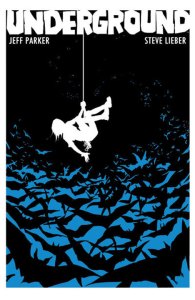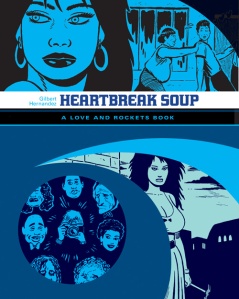Okay, I don’t know if this comic counts as horror in the strictest sense of the term, but it’s one of the first titles that came to mind when I considered this month’s Manga Moveable Feast. It’s one of my favorite spooky-ish comics, and yesterday was Taiyo Matsumoto’s birthday, so…
 “Yeah, well…” a grade-schooler opines early in Taiyo Matsumoto’s GoGo Monster (Viz), “There’s a kid like that in every class, right?” He’s talking about Yuki, a classmate who claims to sense things no one else can, an invisible population of mischievous creatures and a new insurgence of more malevolent beings. And the classmate is right; if manga is to be believed, the schools of Japan are well stocked with young people who traffic in the eerie. None of them are quite like Yuki, though, probably because not many creators are quite like Matsumoto.
“Yeah, well…” a grade-schooler opines early in Taiyo Matsumoto’s GoGo Monster (Viz), “There’s a kid like that in every class, right?” He’s talking about Yuki, a classmate who claims to sense things no one else can, an invisible population of mischievous creatures and a new insurgence of more malevolent beings. And the classmate is right; if manga is to be believed, the schools of Japan are well stocked with young people who traffic in the eerie. None of them are quite like Yuki, though, probably because not many creators are quite like Matsumoto.
Matsumoto has an extraordinary talent for rendering kid logic, their concepts of loyalty and justice and the way they engage with the world around them. This knack was on vivid display in Tekkonkinkreet: Black and White (Viz), for which Matsumoto won an Eisner Award in 2008. Like that book, GoGo Monster features two temperamentally different boys cleaving together to face the inevitable.
Many supernaturally sensitive manga characters can be divided into two categories. They either use that sensitivity to protect the unaware, or they struggle to conceal their abilities for fear of ostracism. Some are driven by both motives, but Yuki answers to neither. He’s disconcertingly matter-of-fact about the things he perceives, and he’s genuinely immune to the ridicule of his peers. He’s an excellent student, but he’s a disruptive presence. Yuki doesn’t perceive his own abnormality, and he doesn’t feel any pressure to conform.
While Yuki has few allies in the student body or faculty, he does garner the sympathetic attention of a new kid at school, Makoto. Average in every respect, Makoto is less intrigued by Yuki’s beliefs than by his indifference to ridicule. Maybe he recognizes it as a kind of strength of character, or maybe some emerging empathy makes him realize Yuki is at risk. Makoto is engaged in all of the aspects of Yuki’s character, not just his oddity. Instead of limiting him to the role of sidekick, this engagement actually makes Makoto Yuki’s equal in terms of reader engagement, or at least it did with me.
Other benevolent figures in Yuki’s sphere include the school’s elderly groundskeeper, Ganz, who understandably takes the long view of things. While the teachers yearn to fix Yuki, Ganz is content to listen to the boy. Then there’s IQ, who is even more ostentatiously weird than Yuki. IQ, who’s in an older grade than Yuki and Makoto, wanders the school grounds with a box on his head with a single eyehole cut into it. It’s telling and slyly funny that this is less disconcerting to his peers and teachers than Yuki’s less obvious strangeness and bursts of temper. Like Ganz, IQ has an odd kind of faith in Yuki, though the source of that faith is oblique.
The most interesting thing about GoGo Monster, the thing that grounds it, is that it’s ultimately irrelevant whether or not the things Yuki perceives are real. It’s Yuki’s belief in their reality and the possible consequences of that belief that drive the drama. That belief is never in question; Yuki is absolutely sincere, as is Matsumoto.
Tekkonkinkreet was set in a dying fantastical city slowly being destroyed by crassness and consumerism. Treasure Town was a richly imagined, almost living place. In GoGo Monster, the school setting couldn’t be more prosaic, but it’s no less vivid. Matsumoto captures the rhythms of the place, the mundane snippets of conversation, the casual cruelty, and the bustle. Even without the meticulous visual detail Matsumoto lavishes on the place, you can practically smell the food from the cafeteria.
 That fidelity makes it all the more effective when you start to see glimpses of it through Yuki’s enhanced perspective. Matsumoto is positively restrained in introducing the weirdness that Yuki sees infesting Asahi Elementary. You glimpse it from the corner of your eye at first, or blink and it disappears. The clearest sense of them comes from Yuki’s crude drawings, and even he admits that they aren’t literal renderings. “This is just a conceptual sketch,” he tells the closest thing he has to a friend. As the school year that constitutes the book’s timeline progresses, Matsumoto reveals more of what Yuki is sensing.
That fidelity makes it all the more effective when you start to see glimpses of it through Yuki’s enhanced perspective. Matsumoto is positively restrained in introducing the weirdness that Yuki sees infesting Asahi Elementary. You glimpse it from the corner of your eye at first, or blink and it disappears. The clearest sense of them comes from Yuki’s crude drawings, and even he admits that they aren’t literal renderings. “This is just a conceptual sketch,” he tells the closest thing he has to a friend. As the school year that constitutes the book’s timeline progresses, Matsumoto reveals more of what Yuki is sensing.
Beyond his marvelous illustrations and elliptical storytelling, the fascinating thing about Matsumoto’s work is his ability to make me root for undesirable outcomes. In Tekkonkinkreet, I found myself hoping that its protagonists would accept the futility of their fight for Treasure Town, that they would cut their losses. In GoGo Monster, I found myself siding with the forces of conformity. Admirable as Yuki’s sense of self is, and enviable as his immunity to social pressure may be, I still was persuaded by Matsumoto’s argument for a healthy, happy Yuki, even if it resulted in a less interesting, less special Yuki.
I should probably mention that GoGo Monster is a beautifully produced book. It’s magnificently colored hard cover comes sheathed in an equally handsome slipcase. The edges of the crisp, white pages are tinged red with a continuation of the cover image. It’s all very lovely, but the book would still be extraordinary even without those bells and whistles. Matsumoto has craft, intelligence, and heart, and he balances those qualities as well as almost any creator alive. In a fairly extraordinary year for challenging, artistically satisfying manga, it seems like a certainty that Matsumoto will garner a second Eisner nomination, perhaps even a second win.











